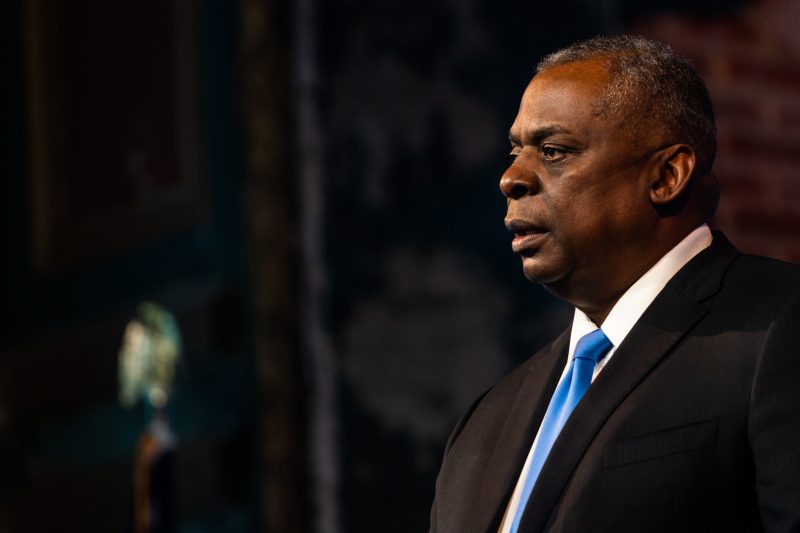President Biden joined his top national security aides on a secure call Jan. 1 to discuss the upheaval threatening to engulf the Middle East and, most urgently that day, find ways to intensify pressure on Houthi militants in Yemen, whose attacks on commercial ships in the Red Sea had jeopardized global commerce.
No one on the teleconference, which also included national security adviser Jake Sullivan, Secretary of State Antony Blinken and other top aides, noticed anything unusual about Defense Secretary Lloyd Austin, the intensely private retired Army general known for his low-drama style and loyalty to the president. Like other officials working remotely during the holiday period, Austin was calling in from his home in Northern Virginia. White House officials expected to see him later that week at a military promotion ceremony.
A few hours later, Austin was instead racing across the Washington suburbs in an ambulance, trailed by his security detail. Suffering nausea and intense pain in his midsection, the 70-year-old was admitted to Walter Reed National Military Medical Center in Maryland, where doctors began immediate treatment for complications from an earlier surgery.
From his hospital bed that night, Austin retained his responsibilities as defense secretary to safeguard America’s nuclear arsenal and oversee 1.3 million military personnel deployed around the world. But the solitary scene was a far cry from the massive retinue that typically surrounds the Pentagon chief on his global movements, including policy and communications staff who provide up-to-the-second operational updates and ensure that he maintains a line to government nerve centers.
Not even Austin’s most senior aides at the Pentagon, top officials at the White House, or Biden himself had any idea of his whereabouts and the threats to his health. Kathleen Hicks, the Pentagon No. 2 who could step in for Austin if needed, was vacationing in the Caribbean.
Four days passed before Austin’s medical crisis was disclosed publicly. The uproar unleashed by the news that the Pentagon chief had undergone two hospitalizations and a surgery following a prostate cancer diagnosis without notifying the White House or Pentagon staff has threatened to overshadow his tenure leading America’s sprawling military enterprise, and created a potentially damaging distraction for Biden as he intensifies his reelection campaign. It has simultaneously triggered a debate over the proper balance between privacy and disclosure for top government officials and what rights, if any, they have in keeping serious medical problems to themselves.
Current and former colleagues said that Austin’s innate introversion and his instinct — honed over decades rising though the Army — to silently manage personal woes may have led him astray.
Austin “is an intensely private person who doesn’t want to be a burden and doesn’t want to be the center of attention,” said one person who knows him well. “It’s in his DNA: be stoic and noble — in this case, maybe to a fault.”
This account of the events surrounding Austin’s hospitalization is based on interviews with more than 10 White House and Pentagon officials, and close scrutiny of the record made public by the administration. Many spoke on the condition of anonymity to discuss the events.
When Biden tapped Austin as his pick for defense secretary following his 2020 victory, it was a sign that the incoming president would prioritize dutifulness and order in his handling of global security.
Unlike an earlier crop of generals who had angered the former vice president as they cultivated large media followings and vigorously pushed their preferred policy outcomes, Austin had proved himself as a reliable officer who shunned the limelight. The general had gotten to know Biden’s late son Beau when the younger Biden served under him in Iraq. He had uncomplainingly executed the 2011 withdrawal from Iraq despite his recommendations against it. Austin’s selection would also represent a milestone for the Pentagon, which had never been led by an African American.
In early December, following routine medical checks, Austin learned he had prostate cancer. The disease, the second most common form of cancer for men, had been caught in its early stages and was considered highly treatable.
But the timing could hardly have been worse. In addition to the escalating violence linked to Israel’s war in the Gaza Strip, U.S. forces were facing a drumbeat of attacks by Iran-linked militants in Iraq and Syria. The Pentagon was also struggling, following a major two-year effort, to help Ukraine gain the upper hand in its war against Russia. In Moscow, Kremlin officials gleefully highlighted the president’s inability to persuade Republican lawmakers to authorize additional aid to Kyiv.
On Dec. 20, Austin returned to Washington after a grueling tour of Middle Eastern capitals, where he struggled to tame escalating regional tensions. Two days later, on the first day of his holiday leave, he was admitted to Walter Reed for a planned prostatectomy, undergoing general anesthesia as doctors removed at least part of his prostate. He returned home the next day.
Not even his chief of staff, Kelly Magsamen, a veteran national security staffer and among those closest to Austin at the Pentagon, knew about the surgery or the cancer diagnosis. While Austin had taken steps ahead of his procedure to temporarily transfer authority for certain operational matters to Hicks, his deputy, while he was in surgery — which required sending an email to Hicks’s staff — it was a periodic move that, in this instance, Magsamen and others didn’t know was linked to medical issues.
Two days later, on Christmas Day, with administration officials scattered for the holidays, Sullivan convened another call to discuss the administration response to the spate of drone and missile attacks on American forces in Iraq and Syria.
Sullivan and Austin, who was then recovering at home, coordinated between themselves before a second call with Biden and other top officials. Austin recommended that Biden authorize a strike in Baghdad to assassinate the head of an Iran-backed militia deemed responsible for orchestrating numerous attacks on American troops. Biden did so. The strike would be conducted during an upcoming window, whenever military leaders identified the optimal moment.
When Austin returned to the hospital on New Year’s Day, he had severe pain in his leg, hip and abdomen. According to his physicians, he had developed a urinary tract infection and, they discovered, a blocked intestine. The next day, Jan. 2, he was sick enough that his doctors placed him in intensive care. His junior military aide, who had returned from holiday leave when he learned what had happened, was notified and arrived at Walter Reed to see his boss.
Only then, the day after he was admitted, did word of Austin’s whereabouts begin to spread among a small group of top Pentagon aides. Among those who learned on Jan. 2 were Magsamen, who was home that week with the flu; Lt. Gen. Ronald Clark, Austin’s senior military assistant; Christopher Meagher, a senior public affairs official; and Maj. Gen. Pat Ryder, the Pentagon press secretary.
No one moved to inform the White House or Hicks, who by then was on vacation with her family in Puerto Rico. That was despite the fact that Austin, facing a serious emergency, had decided to again delegate key operational authorities as he was moved to the ICU, making her responsible for the most consequential life-or-death matters the Pentagon oversees.
Officials said that Hicks, a veteran defense policy expert, had traveled to the Caribbean in a military plane, accompanied by communications and other staff, in keeping with the department’s rules. While she could operate from afar, she remained in the dark about the reason for the authority transfer.
Back in Washington, the Biden administration was slowly lurching into action after the holidays. That evening, Biden returned from his vacation in St. Croix, where he had been accompanied by Sullivan and other aides.
The next day, on Jan. 3, Sullivan led a White House meeting focused on spiraling insecurity in Haiti. Representing the Pentagon was Sasha Baker, a top policy official, and Adm. Christopher Grady, the vice chairman of the Joint Chiefs of Staff. No one at the White House suspected that Austin was in the ICU — or that Hicks had been designated to act on his behalf.
They remained unaware the following day when, on Jan. 4, U.S. forces carried out the airstrike targeting a senior militia commander in Iraq, culminating the operation that Austin had recommended on Christmas Day. Gen. Michael “Erik” Kurilla, head of U.S. Central Command, which coordinates American military activity throughout the Middle East, directed the attack, keeping the Pentagon and White House informed.
The next morning, senior military officials informed White House officials about the operation, and Biden was briefed on the results. Later that afternoon, Sullivan and his deputy, Jon Finer, were driving to Fort Myer across the Potomac in Arlington, Va., for a ceremony honoring James Mingus, an Army general who was being elevated to the service’s vice chief of staff. They had been expecting to see Austin there and meet with him afterward to discuss several issues.
But as they were en route, shortly before 4 p.m., Sullivan received a call from Magsamen. Austin had been in the hospital for the past three days, she told him.
Austin would not be at the Mingus event. And Sullivan quickly realized the administration had a bigger problem at hand. He called White House chief of staff Jeff Zients, telling him that there was an issue to discuss and that he needed to brief him immediately upon return to the White House.
When Sullivan and Finer arrived back at the White House, they gathered in Zients’s office in the West Wing. It was just before 6 p.m., and they quickly pulled in senior adviser Anita Dunn, White House counsel Ed Siskel and John Kirby, the coordinator for strategic communications at the National Security Council.
Sullivan relayed to everyone that he had just found out that afternoon that Austin had been in the hospital and was in intensive care. Sullivan called Magsamen at the Pentagon. They established a line of communication with Hicks, who had been informed herself of Austin’s situation only that afternoon, also by Magsamen. Sullivan and Zients told both Magsamen and Hicks, in separate conversations, that as soon as possible they had to publicly disclose that Austin had been hospitalized.
Sullivan and Zients briefed the president shortly before 7 p.m. While no one at the White House or the Pentagon knew exactly what Austin’s initial surgery or condition had been, they knew they needed to move fast to address the fact that he was in intensive care.
After Hicks found out, she began planning to cut short her vacation and return to Washington, officials said, but decided to remain in Puerto Rico after learning that Austin was planning to resume his duties the following day, Jan. 5.
Despite the White House’s urging, the Pentagon did not disclose the news for nearly 24 hours, issuing a terse three-sentence statement after 5 p.m. that Friday that vaguely referenced an elective procedure but failed to mention Austin’s earlier stay at Walter Reed or the underlying medical issue. The timing of the statement, and its dearth of information, was met with concern from lawmakers and outrage from the Pentagon press corps.
By Saturday afternoon, Jan. 6, with questions rippling across Washington, Biden placed a call to Austin. Rather than being angry about the lapse, aides said, the president wanted to hear how his defense chief was doing and wish him well.
The call was brief, and administration officials described it as “warm.” But when the two men hung up, Biden still did not know what Austin’s medical issue was, either because the president didn’t ask or Austin didn’t offer it.
As the days passed and more details dripped slowly into public view, administration officials realized their attempts to stanch the uproar were falling short. On Capitol Hill, Republicans accused Austin of endangering national security and violating notification rules. Soon, even Biden’s Democratic allies were making their objections known. Sen. Jack Reed (D-R.I.), the influential chairman of the Senate Armed Services Committee, demanded that such a lapse “never happen again.”
The news wasn’t bad only for the Pentagon. Even as they stood by Austin, officials at the Pentagon and White House privately expressed puzzlement and frustration about his instinct for secrecy. By Monday, Jan. 8, his hospitalization — and, particularly, the continued mystery surrounding the underlying condition — had overshadowed a news cycle the White House had hoped would highlight Biden’s campaign rollout and distracted from a speech he gave in South Carolina, a key state in the 2024 election calendar.
On Tuesday morning, Jan. 9, the extended mystery came to an end. Pentagon officials learned of the diagnosis as they worked with Austin’s doctors to put out a statement on his medical timeline. At the White House, Zients informed Biden that it was prostate cancer. Biden has been particularly impacted by cancer — his son Beau died of brain cancer — and he has made both fighting it and grieving over its impacts a key way to connect with voters and push it as a policy priority.
Biden, in his most direct comments so far, said Friday that it was a lapse in judgment for Austin not to inform him earlier but reiterated that he still had confidence in his defense secretary.
But while lawmakers from both parties expressed their sympathy, they continued to demand accountability and answers from the Pentagon: who knew what, when — and why breakdowns in such sensitive communications had occurred.
Hoping to contain the fallout, Zients sent a memo to Cabinet members, launching a review of procedures for when they are hospitalized or need to delegate their authority. In such instances, he said, they need to inform the White House.
Magsamen ordered a separate Pentagon review of what had occurred. Several days later, the department’s inspector general launched its own investigation.
At the Pentagon, some officials questioned how Austin could have overlooked a rule inculcated into military personnel from the lowest ranks: that troops must report issues up the chain that prevent them from effectively doing their jobs.
“The bottom line is that the political appointee staff failed,” one senior official said of those closest to Austin. “To become a distraction in an election year is pretty unforgivable staff work.”
This past Thursday, the matter that Biden discussed with his aides on New Year’s Day, just hours before Austin’s second hospitalization set off the chaos, came to an explosive head.
American naval and air forces, working with British counterparts, struck dozens of Houthi targets in Yemen, hoping to deal a decisive blow to their ability to threaten maritime commerce. The attack followed widespread international rejection of the group’s escalating attacks, but it also represented a risky move for the Biden administration as it seeks to extinguish, not encourage, regional destabilization.
Pentagon officials said that Austin, still at Walter Reed more than 10 days later, helped to direct the operation from his hospital room.
Abigail Hauslohner and Michael Birnbaum contributed to this report.


















